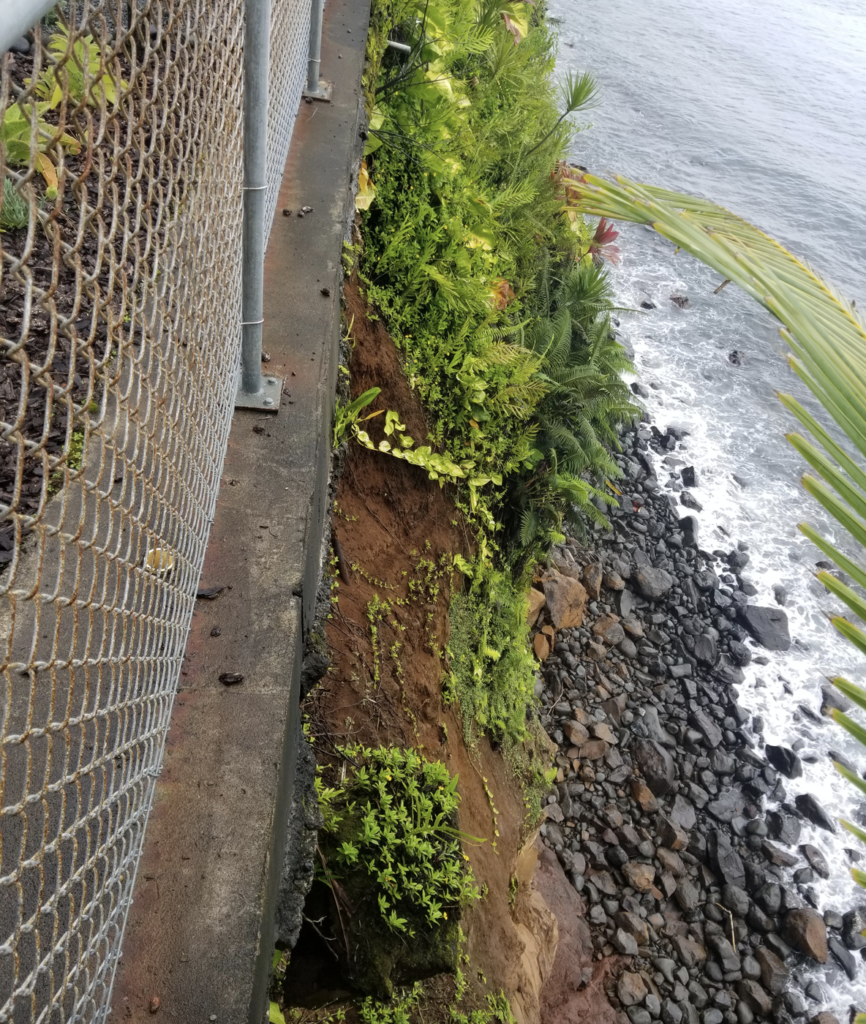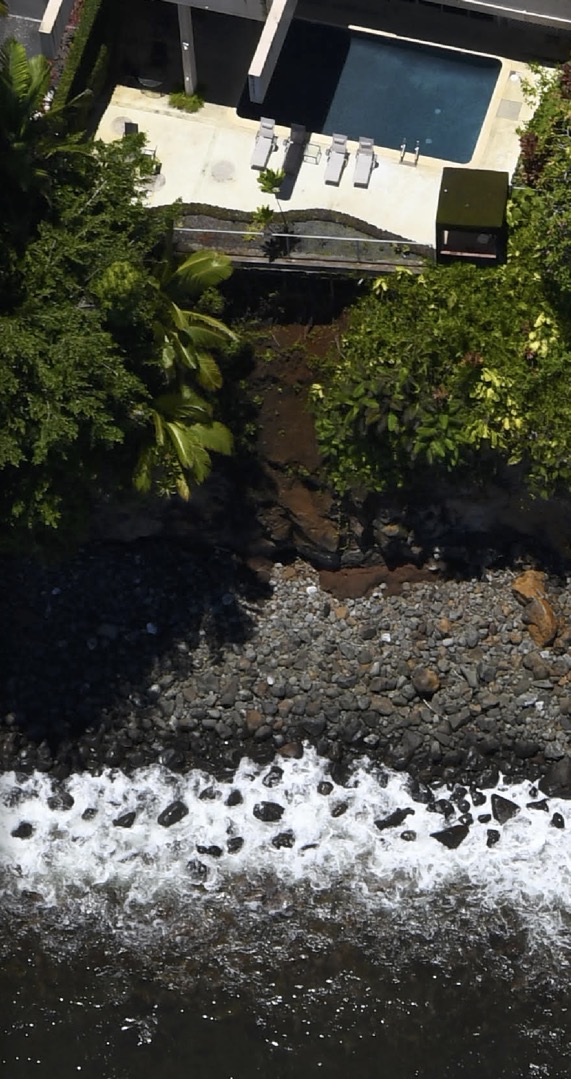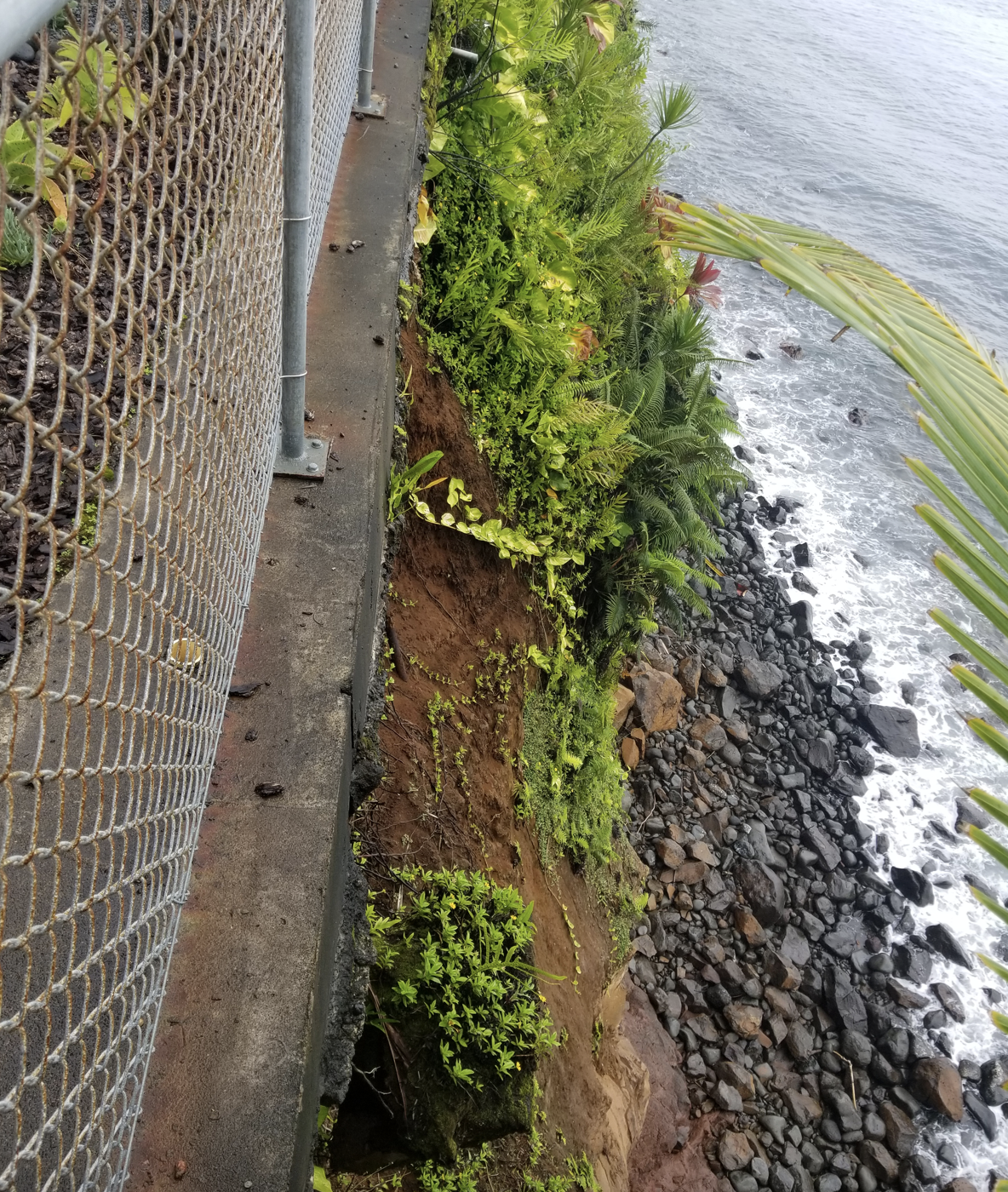Above photo: A drone photo of the cliff face in front of the Bayshore Towers. (Credit: Ryan Perroy)
The Bayshore Towers condominium is an iconic fixture of the Hilo shoreline. The tall, pinkish building clings to the coast on a high cliff point just north of the Singing Bridge that links the town to the Hamakua Coast. The 15-story condominium complex is the tallest structure on the island, having received in the 1960s a permit to build before the county banned future construction of such tall buildings.
Now, like so many other near-shore structures across the state, it is confronting the problem of coastal erosion.
Last year, the homeowners’ association applied for a permit to undertake a $2 million shoreline stabilization project. In late March, the county Planning Department approved the work.
This isn’t the first time the buildings’ owners have attempted to address an eroding cliff face. According to the application, “Around 2004 Meta Engineering proposed a slope stabilization solution that included a grade beam at the top of the slope supported by vertical piers and horizontal tie backs. This solution was completed and has failed. The failed piers can be seen on the cliff face.”
In 2016 another engineering company proposed “installing vertical piers on the pool to remove the vertical load on the slope. Their assumption was that if the pool weight was removed from the slope, the slope would stabilize.” No work was undertaken at that time.
In 2019, JPB Engineering “did a full geotechnical investigation,” including three borings down more than 20 feet. Based on the borings, soil analysis, and engineering analysis, “it was determined that the cliff consists of material that is susceptible to erosion for the upper 20 feet. Below 20 feet (approximately) is stable rock.” Jonathan Brandt, principal of JPB, applied for and was issued the permit for the current project.
Despite the price tag, Zendo Kern, county planning director, issued a Special Management Area minor permit to cover the work. No shoreline certification was required, he wrote. The shoreline is situated at the base of the cliff, while “all work will occur within the shoreline setback area.” Hence, “a shoreline certification will not be required for the proposed project as it is unnecessary to determine the setback location.”
Plans and photos submitted to the county show a nearly vertical cliff face that is covered in vegetation – shrubs, grasses, and palms. The proposed work will remove the vegetation but, Kern says, “will not alter the exiting [sic] grade of the shoreline setback area other than to smooth out eroded areas that will eventually collapse into the ocean.”

The engineering firm intends to cover the cliff face with more than five inches of concrete. “The removal of loose material will result in the edge of the cliff moving more inland,” the application states, necessitating removal of a garden wall and walkway near the swimming pool and loss of at least one parking space – although these are to be restored after the project is completed.
As described in the application and approval letter, the pali (cliff) is “approximately 30 feet tall with the top 20 feet being unconsolidated lose [sic] sediment, and the bottom 10 feet being rock. The vegetation and loose soil will be removed, followed by an inch-and-a-half “flash coat” of concrete. Soil anchors will be placed every six feet along three horizontal rows on the cliff face, then more concrete, four-and-a-half inches thick, will be applied to the cliff face.
“Once the pali face is completed,” the plans state, “the soil anchors will be connected via galvanized steel plates to the concrete.”
To clear the cliff face, “men will move up and down the slope removing all the vegetation and loose material.” The application states that, “on past projects, governing agencies required a platform be built and lowered into place below the workers so that any loose material that fell would be captured.”
The county approval doesn’t require this. Instead, Kern writes: “The applicant states that debris removed during smoothing of the pali face will be collected… No material will enter the ocean.”
Despite the project’s eye-popping cost, the planning director determined that it was a permitted activity within the Special Management Area. The letter takes note of a permit issued in December 2004, allowing construction of a “seacliff retention system.” At that time, “It was determined that the proposed project was considered to be a ‘minor structure or activity.’”
In the March letter, Kern goes on to justify issuance of a minor permit on the basis of that the action is needed “to maintain an existing portion of an apartment building” and that it won’t interfere with shoreline access or public views. Further, there are no “public viewplanes that will be affected by this project.”
“Based on the preceding information, the Planning Department has determined the proposed activity may be permitted in the shoreline setback area without the need for a shoreline setback variance pursuant to Planning Department Rule 11-8: Minor Structure and Minor Activity.”
— Patricia Tummons



Jenise Mamone
Is buying in this complex a safe bet on life safety and monetary investment. Current and future time?